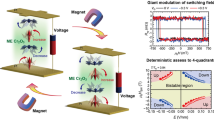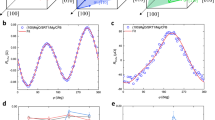Abstract
Voltage-controlled spin electronics is crucial for continued progress in information technology. It aims at reduced power consumption, increased integration density and enhanced functionality where non-volatile memory is combined with high-speed logical processing. Promising spintronic device concepts use the electric control of interface and surface magnetization. From the combination of magnetometry, spin-polarized photoemission spectroscopy, symmetry arguments and first-principles calculations, we show that the (0001) surface of magnetoelectric Cr2O3 has a roughness-insensitive, electrically switchable magnetization. Using a ferromagnetic Pd/Co multilayer deposited on the (0001) surface of a Cr2O3 single crystal, we achieve reversible, room-temperature isothermal switching of the exchange-bias field between positive and negative values by reversing the electric field while maintaining a permanent magnetic field. This effect reflects the switching of the bulk antiferromagnetic domain state and the interface magnetization coupled to it. The switchable exchange bias sets in exactly at the bulk Néel temperature.
This is a preview of subscription content, access via your institution
Access options
Subscribe to this journal
Receive 12 print issues and online access
$259.00 per year
only $21.58 per issue
Buy this article
- Purchase on Springer Link
- Instant access to full article PDF
Prices may be subject to local taxes which are calculated during checkout




Similar content being viewed by others
References
Wolf, S. A. et al. Spintronics: A spin-based electronics vision for the future. Science 294, 1488–1495 (2001).
Žutić, I., Fabian, J. & Das Sarma, S. Spintronics: Fundamentals and applications. Rev. Mod. Phys. 76, 323–410 (2004).
Zhirnov, V. V., Hutchby, J. A., Bourianoff, G. I. & Brewer, J. E. Emerging research logic devices. IEEE Circuits Devices 21, 37–46 (2005).
Ney, A., Pampuch, C., Koch, R. & Ploog, K. H. Programmable computing with a single magnetoresistive element. Nature 425, 485–487 (2003).
Binek, Ch. & Doudin, B. Magnetoelectronics with magnetoelectrics. J. Phys. Condens. Matter 17, L39–L44 (2005).
Dery, H., Dalal, P., Cywiński, Ł. & Sham, L. J. Spin-based logic in semiconductors for reconfigurable large-scale circuits. Nature 447, 573–576 (2007).
Zavaliche, F. et al. Electrically assisted magnetic recording in multiferroic nanostructures. Nano Lett. 7, 1586–1590 (2007).
Tsymbal, E. Y. & Kohlstedt, H. Applied physics: Tunneling across a ferroelectric. Science 313, 181–183 (2006).
Maruyama, T. et al. Large voltage-induced magnetic anisotropy change in a few atomic layers of iron. Nature Nanotech. 4, 158–161 (2008).
Velev, J. P., Dowben, P. A., Tsymbal, E. Y., Jenkins, S. J. & Caruso, A. N. Interface effects in spin-polarized metal/insulator layered structures. Surf. Sci. Rep. 63, 400–425 (2008).
Nogués, J. & Schuller, I. K. Exchange bias. J. Magn. Magn. Mater. 192, 203–232 (1999).
Chappert, C., Fert, A. & Van Dau, F. N. The emergence of spin electronics in data storage. Nature Mater. 6, 813–823 (2007).
Borisov, P., Hochstrat, A., Chen, X., Kleemann, W. & Binek, Ch. Magnetoelectric switching of exchange bias. Phys. Rev. Lett. 94, 117203 (2005).
O’Dell, T. H. The Electrodynamics of Magneto–Electric Media (North-Holland, 1970).
Borisov, P., Hochstrat, A., Shvartsman, V. V. & Kleemann, W. Superconducting quantum interference device setup for magnetoelectric measurements. Rev. Sci. Instrum. 78, 106105 (2007).
Fiebig, M. Revival of the magnetoelectric effect. J. Phys. D 38, R123–R152 (2005).
Wang, J. et al. Epitaxial BiFeO3 multiferroic thin film heterostructures. Science 299, 1719–1722 (2003).
Hur, N. et al. Electric polarization reversal and memory in a multiferroic material induced by magnetic fields. Nature 429, 392–395 (2004).
Eerenstein, W., Mathur, N. D. & Scott, J. F. Multiferroic and magnetoelectric materials. Nature 442, 759–765 (2006).
Bibes, M. & Barthélémy, A. Multiferroics: Towards a magnetoelectric memory. Nature Mater. 7, 425–426 (2008).
Lottermoser, T. et al. Magnetic phase control by an electric field. Nature 430, 541–544 (2004).
Sahoo, S. et al. Ferroelectric control of magnetism in BaTiO3/Fe heterostructures via interface strain coupling. Phys. Rev. B 76, 092108 (2007).
Weiler, M. et al. Voltage controlled inversion of magnetic anisotropy in a ferromagnetic thin film at room temperature. New J. Phys. 11, 013021 (2009).
Laukhin, V. et al. Electric-field control of exchange bias in multiferroic epitaxial heterostructures. Phys. Rev. Lett. 97, 227201 (2006).
Chu, Y-H. et al. Electric-field control of local ferromagnetism using a magnetoelectric multiferroic. Nature Mater. 7, 478–482 (2008).
Zhao, T. et al. Electrical control of antiferromagnetic domains in multiferroic BiFeO3 films at room temperature. Nature Mater. 5, 823–829 (2006).
Liu, J. P., Fullerton, E., Gutfleisch, O. & Sellmyer, D. J. (eds) in Nanoscale Magnetic Materials and Applications Ch. 6 (Springer, 2009).
Lim, S-H. et al. Exchange bias in thin-film (Co/Pt)3/Cr2O3 multilayers. J. Magn. Magn. Mater. 321, 1955–1958 (2009).
Kuch, W. et al. Tuning the magnetic coupling across ultrathin antiferromagnetic films by controlling atomic-scale roughness. Nature Mater. 5, 128–133 (2006).
Krichevtsov, B. B., Pavlov, V. V. & Pisarev, R. V. Nonreciprocal optical effects in antiferromagnetic Cr2O3 subjected to electric and magnetic fields. Zh. Eksp. Teor. Fiz. 94, 284–295 (1988).
Freund, H-J., Kuhlenbeck, H. & Staemmler, V. Oxide surfaces. Rep. Prog. Phys. 59, 283–347 (1996).
Martin, T. J. & Anderson, J. C. Antiferromagnetic domain switching in Cr2O3 . IEEE Trans. Magn. 2, 446–449 (1966).
Bromwich, T. J. et al. Remanent magnetic states and interactions in nano-pillars. Nanotechnology 17, 4367–4373 (2006).
Kresse, G. & Hafner, J. Ab initio molecular dynamics for open-shell transition metals. Phys. Rev. B 48, 13115–13118 (1993).
Kresse, G. & Furthmueller, J. Efficiency of ab inito energy calculations for metals and semiconductors using a plane-wave basis set. Comput. Mater. Sci. 6, 15–50 (1996).
Kresse, G. & Furthmueller, J. Efficient iterative schemes for ab initio total-energy calculations using a plane-wave basis set. Phys. Rev. B 54, 11169–11186 (1996).
Acknowledgements
This work is supported by NSF through Career DMR-0547887, by the Nebraska Research Initiative (NRI), by the NSF MRSEC Grant No. 0820521 and by the NRC/NRI supplement to MRSEC. K.D.B. is a Cottrell Scholar of Research Corporation. Technical help from S-Q. Shi, V. R. Shah and L. P. Yue in the calculation of DOS, taking XRD and AFM data is acknowledged, respectively. We are thankful to Crystal GmbH for providing excellent Cr2O3 single crystals.
Author information
Authors and Affiliations
Contributions
X.H. and C.B. designed the study, in particular conceiving the electrically controlled exchange bias and electrically controlled magnetism. Y.W. and X.H. collected and analysed the magnetic data. N.W. led the photoemission experiments and data analysis. A.C. and E.V. supported the photoemission experiments. K.D.B. conceived the concept of roughness-insensitive surface magnetization and directed the electronic structure calculations. P.A.D. directed and conceived the photoemission experiments. C.B. directed the overall study. All authors contributed to the scientific process and the refinement of the manuscript. C.B. and X.H. wrote most of the paper.
Corresponding author
Ethics declarations
Competing interests
The authors declare no competing financial interests.
Supplementary information
Supplementary Information
Supplementary Information (PDF 644 kb)
Rights and permissions
About this article
Cite this article
He, X., Wang, Y., Wu, N. et al. Robust isothermal electric control of exchange bias at room temperature. Nature Mater 9, 579–585 (2010). https://doi.org/10.1038/nmat2785
Received:
Accepted:
Published:
Issue Date:
DOI: https://doi.org/10.1038/nmat2785
This article is cited by
-
Giant gate modulation of antiferromagnetic spin reversal by the magnetoelectric effect
NPG Asia Materials (2024)
-
Topological surface magnetism and Néel vector control in a magnetoelectric antiferromagnet
npj Quantum Materials (2023)
-
Manipulating exchange bias in 2D magnetic heterojunction for high-performance robust memory applications
Nature Communications (2023)
-
Recent development of E-field control of interfacial magnetism in multiferroic heterostructures
Nano Research (2023)
-
Electrically manipulating magnetization reversal via energy band engineering
Science China Physics, Mechanics & Astronomy (2023)



